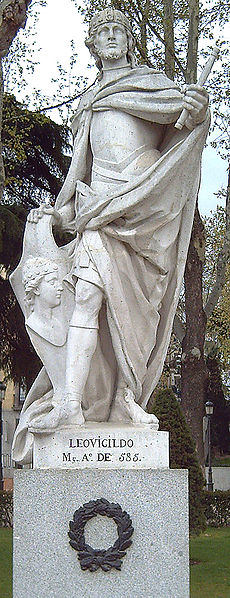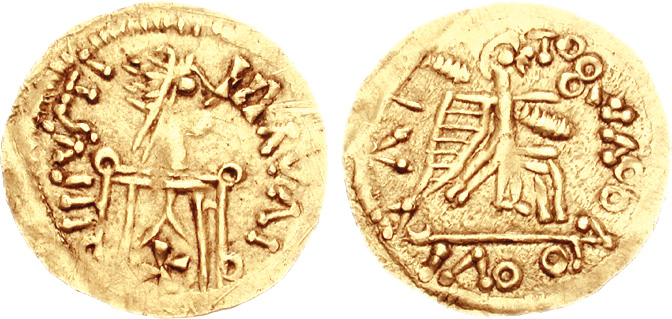<Back to Index>
- King of the Visigoths Liuvigild, 6th Century
PAGE SPONSOR

Liuvigild, Leuvigild, Leovigild, or Leogild was a Visigothic King of Hispania and Septimania from 569 to April 21, 586. From 585 he was also king of Galicia. Known for his Codex Revisus or Code of Leovigild, a unifying law allowing equal rights between the Visigothic and Hispano - Roman population, his kingdom covered most of modern Spain down to Toledo. He was born circa 525.
In the second year of his reign, king Liuva I declared his brother Liuvigild co-king, assigning him Hispania Citerior, or the eastern part of Hispania, to directly rule over. Both were Arian Christians.
Liuvigild was married twice: first to Theodosia, who bore him two sons Hermenegild and Reccared, and after her death to Athanagild's widow Goiswintha.
According to the chronicle of John of Biclaro, as co-king Liuvigild initiated the first of several campaigns to expand the territory of the kingdom of the Visigoths, which Peter Heather describes as a "list of striking successes". His first strike was in 570, when he "laid waste the region of Bastetania and the city of Malaga, defeating their soldiers". The following year he captured Medina Sidonia, assisted "through the treachery of a certain Framidaneus." Then, around the time he became sole ruler with the death of his brother Liuva (which occurred in either 571 or 572), seized Córdoba from the Byzantine Empire. During the civil war which ended with Athanagild rise to power some twenty years earlier, the Byzantines gained control of a stretch of territory in the southeast of the Iberian Peninsula. John of Biclaro notes that upon gaining control of Córdoba, Liuvigild "slaughtered the enemy troops and made the city his own."
His campaigns continued on an annual basis over the next five years. Liuvigild invaded Sabaria in 573, ravaging a people known as the Sappi and bringing that province under his control. Then the next year he entered Cantabria, seized Amaya, and added that province to his kingdom. In 575 he marched into Galicia, defeating a local warlord named Aspidius and taking him, his treasure and his family into captivity. In 576, he marched on the kingdom of the Suevi in northwestern Hispania, but king Miro managed to negotiate a peace with Liuvigild. In his final campaign (577) Liuvigild marched into Orespeda, a region in southeastern Spain, and after suppressing an immediate revolt "of the common people" added this province to his kingdom. Upon the conclusion of these campaigns, Liuvigild celebrated his victories by founding a city in Celtiberia, which he named Recopolis for his son Reccared.
Though
constantly at war with the Byzantines in southern Hispania, Liuvigild
accepted the administration of the Byzantine Empire, adopted its pomp and ceremony, and imitated its coinage.
The Visigoths were still a military aristocracy and kings had to be formally ratified by the nobility. Visigoths and their Ibero - Roman subjects were still separated by religion and by distinct law codes. Liuvigild modified the old Code of Euric which governed the Goths and created his own Codex Revisus. He also repealed old Roman laws dating back to the late 4th century forbidding intermarriage between Visigoths and Ibero - Romans.
Liuvigild further secured a peaceful succession, a perennial Visigothic issue, by associating his two sons, Hermenegild and Reccared, with himself in the kingly office and placing certain regions under their regencies. Hermenegild, the elder, was married to Inguthis, daughter of the Frankish King Sigibert I.
In 582 Liuvigild captured Mérida, which had been under the political control of its popular bishop Masona since the early 570s. Masona was soon after exiled for three years, possibly in the context of the rebellion of Hermenegild.
Hermenegild had converted to Orthodox Christianity, persuaded by his Frankish wife Ingunthis and Leander, bishop of Seville. After his father, who considered this conversion treason, insisted on appointing Arians as bishops, Baetica in
583 revolted under the leadership of Hermenegild, who was supported by
the orthodox bishops. When the Byzantines failed to aid the revolt,
Liuvigild besieged and took Seville and banished his son to Valencia, where he was murdered by Liuvigild's agents. Leander of Seville was
also banished and later canonized as a saint. Ingunthis was delivered to
the Eastern Emperor Tiberius II Constantine and was last heard of in Africa. These events are described in vivid details by Pope Gregory I (Dialogi, III, 31). After this rebellion, Liuvigild reportedly demanded that his Roman subjects convert to Arianism.
Liuvigild went on to subdue the Basques. In the north Liuvigild took advantage of internecine friction among Suebi factions in dispute over a succession and, in 584, he defeated the Suebic kingdom in the great battle of Braga and added the kingdom to his crowns. By the end of his reign, only the Basque lands and two small territories of the Byzantine Empire made up the non - Visigothic parts of Iberia.
Liuvigild's last year was troubled by open war with the Franks along his northernmost borders. But overall, Liuvigild was one of the more effective Visigothic kings of Hispania, the restorer of Visigothic unity, ruling from his capital newly established at Toledo, where he settled toward the end of his reign. (From this, the Iberian Visigothic monarchy is sometimes called the "Kingdom of Toledo").
The Visigoths in Hispania considered themselves the heirs of western Roman imperial power, not its enemies. Until Liuvigild's reign, the Visigoths minted coins that imitated the imperial coinage of Byzantium which circulated from Byzantine possessions in Baetica. From the reign of Liuvigild onwards, however, the Visigothic kingdom issued coarse coinage of its own designs. While facing the rebellion in southern Hispania, Liuvigild struck an issue of tremisses with a cross on steps on the reverse, a design that had been introduced for the very first time on Byzantine solidi by Emperor Tiberius II (578 – 582).
City - oriented Ibero - Roman culture continued to erode during Liuvigild's reign. There evolved in Visigothic Hispania the new post - Imperial pattern of regional and local overlordship based upon regional dukes (duces), who were military leaders, and lords of smaller districts or territories called counts (comes). A similar evolution was taking place in Italy and, more slowly, in the east as well. The new ducal administrations tended to coincide with the old Roman provinces; the territories of the counts with the old cities and their small hinterlands.
He was succeeded by his second son Reccared,
who converted to Orthodox Christianity in 589 and brought religious and
political unity between the Visigoths and their subjects.
